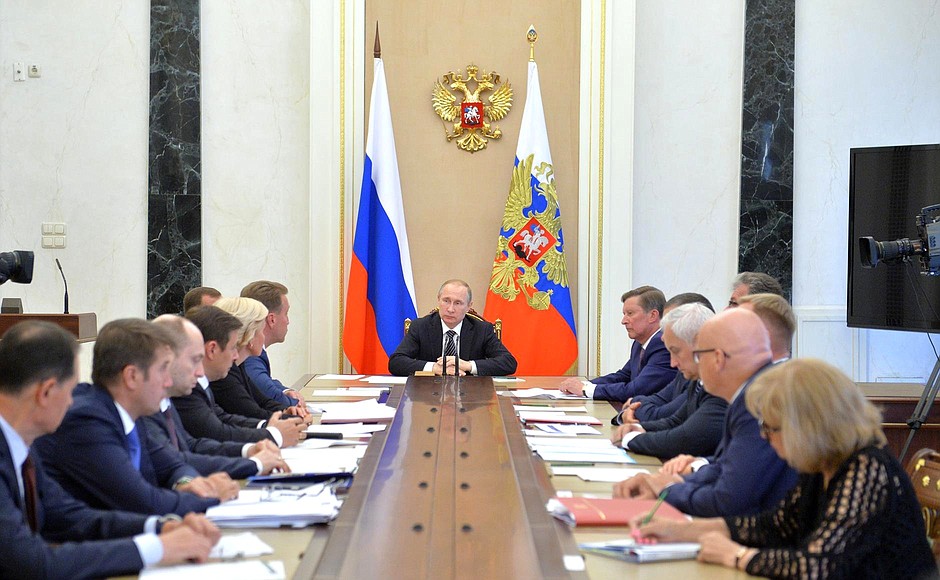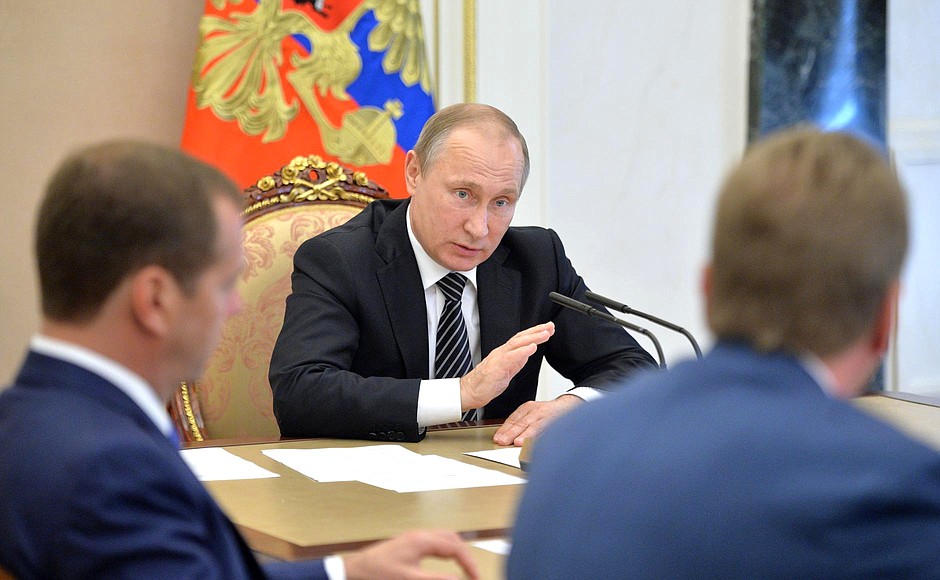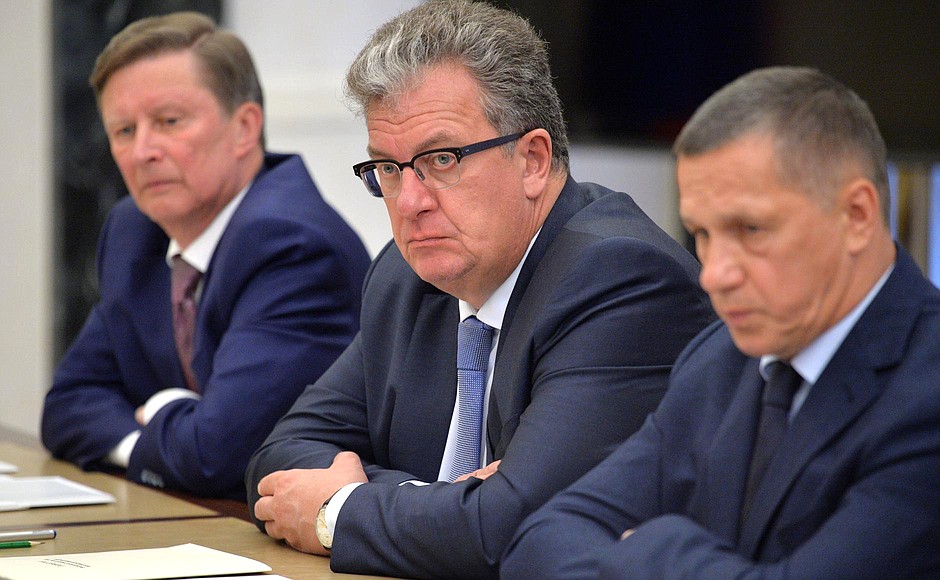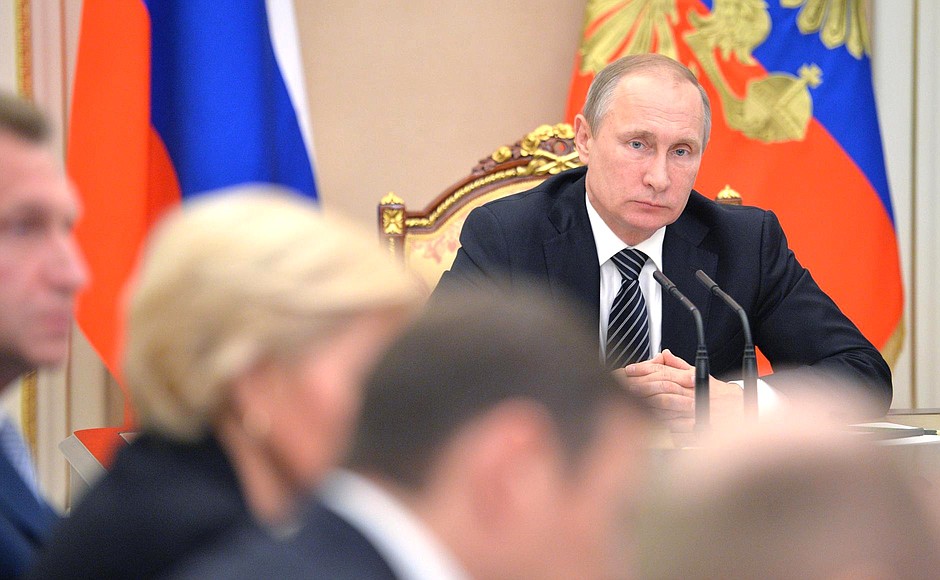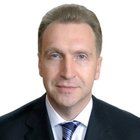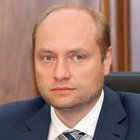President of Russia Vladimir Putin: Good afternoon colleagues,
We agreed to discuss matters regarding the development of the Far East today and to look at the progress in implementing our plans in this area and the development measures for this very important part of the country.
But before we move on to the main item on our agenda, I would like to ask [Education and Science Minister] Mr Livanov to say a few words about the results of this year’s national final school exam and the university application period, and then I would like to hear from [First Deputy Prime Minister] Mr Shuvalov on the situation with single-employer towns. This is an important issue, after all, and we should keep it in our sight, all the more so as I know the Government has recently taken some new decisions in this area.
You have the floor.
Education and Science Minister Dmitry Livanov: Mr President, colleagues,
On August 8, our universities concluded admissions for full-time undergraduate students. This year, as we decided on the non-fee-based student numbers and distribution, we put the emphasis on engineering, medical and teacher-training specialities. Why did we?
We chose these fields because graduate employment monitoring showed that these particular areas are in demand with employers, the employment rate is higher, and the salary in the first year following graduation is higher than in other areas.
Universities will be taking on more than 507,000 non-fee-based students this year and we have a situation where around 60 percent of school graduates can opt for an affordable university course in their first year. This has been the case over the past 5 years and we plan to maintain this level in the future.
Labour market demand determines non-fee-based education distribution among particular universities, specialities and regions. This also influences the student numbers coming into this or that field of study. This year, student numbers have risen considerably in engineering and natural sciences, chemistry and biology, for example, and also in information security, nuclear energy, aircraft construction, shipbuilding – up 20 percent, nanotechnology – up 18 percent, and medicine. This year, nearly half of all the new students are future engineers, 9 percent are future teachers, and 8.5 percent are future doctors.
I would also like to note that applicants to universities show growing interest in these particular fields of study, and although we have greater admission numbers and expanded opportunities in these areas, the number of students competing for each opening continues to grow. In the technical fields, this year, it was eight applicants for one opening.
As concerns the national final school exam, it was very well organised this year, transparent, with a minimum of breaches of the rules. There were no leaks of exam material to the internet this year and no cases of mass copying or cheating at the exams.
The fact that we now make very wide use of a video surveillance system has helped a lot to improve the situation. This year, around 80 percent of examination venues were equipped with this system. Next year, we will have 90 percent of venues equipped.
Honest exams are a very important indicator of the quality of education in our view. When we first held this exam in the proper open and transparent conditions three years ago, we saw that in a number of regions, students’ results were substantially lower than the national average.
We then began taking targeted measures to improve teaching quality in Russian language and maths in these regions. Our top teacher-training universities have been involved in this project and we are beginning to see the results now.
This year, for example, the number of students who did not receive the minimum threshold mark dropped considerably and is now less than one percent. These are the students who failed the exam and thus did not receive their school-leaving certificate. However, this year, for the first time, they will have the chance to re-sit the exam in September and will then be able to enter a vocational education programme this year and not lose an academic year.
Let me note that the structure of the exams is changing too. In the foreign language exams, we are reducing the test part of the exam and introducing an oral section. Over the next two-three years, we will test this same model for the Russian language exam as well, and will then introduce it for Russian and perhaps other subjects in the humanities. Students in their 11th year of school have shown growing interest in the possibility of choosing which natural sciences exams to sit. This year, for example, we had 21,000 more students than last year sitting the physics exam.
International competitions are currently underway in the different school subjects, and our national teams have achieved some very good results. Four such competitions (in maths, physics, chemistry and biology) are currently underway and all of our teams have demonstrated much better results than over past years.
Our teams came in second in the world in chemistry, fourth in physics and were the best team from Europe, they earned a high score in biology, and won four gold medals in maths, a much better result than last year.
I would like to note that our maths team had a training session at the Sirius Centre, and the trainers said that this had an excellent effect on the results. We have many talented young people. Let me give one example.
Alexander Artemyev from Kirov Region scored a unique result in the national final school exam with full marks in three subjects – maths, physics, and informatics. He won the national physics competition, is a member of our national physics team, and at the international competition in Zurich in August, he not only won a gold medal but also a prize as the best theoretician. In other words, he outperformed all other competitors in the theoretical round of the competitions and was recognised as the top participant from Europe. Our education system’s task is to give each child, each student, the opportunity to develop their talents as much as possible.
We are now actively preparing for the start of the new school year, inspecting schools’ readiness for the Day of Knowledge [the start of the school year on September 1], inspecting school safety, and we are certain that all educational establishments will be ready for the new school year.
I would also like to note that we launched a large-scale programme this year to add capacity to the school system. Ninety-two new schools will be ready to open their doors on September 1 this year. This is unprecedented for these last years. Overall, we have nearly 200 schools under construction. They will open their doors next year. Of course, this programme will continue.
This ends my report. Thank you.
Vladimir Putin: Good. Is the average mark around the country higher than 7?
Dmitry Livanov: The average mark in the national final school exam has increased slightly in all subjects but is overall close to last year’s level.
Vladimir Putin: That was a slip of the tongue and I did not mean the exam grades but the average number of students competing for each place in the universities.
Dmitry Livanov: The average is around 7.
Vladimir Putin: Is it around 7 or higher than 7?
Dmitry Livanov: It is 7.3. We are only just clarifying the results now because the universities finalised their admission results for this year only on August 8, and we will have the final figures ready within the next two weeks, but overall, the competition was higher than last year.
Vladimir Putin: Good.
Mr Shuvalov, let us hear from you now on the single-industry towns.
First Deputy Prime Minister Igor Shuvalov: Mr President, colleagues,
The government has been actively monitoring the situation in the single-industry towns since autumn 2008. We have come to a realisation that of the 319 single-industry towns, around 100 are in a very difficult situation. Monitoring concentrates on these 319 towns, and we have around 100 towns in the red zone.
These towns are home to 9 percent of Russia’s population, more than 7 million people of working age. The level of registered unemployment is slightly higher than the national average. The national average is 1.3 percent, and in these towns the rate is one percent higher.
Now, what we are doing today, Mr President. When you held a meeting of the Council for Strategic Development and Priority Projects, you identified areas in which the Government would work together with parliament and national and regional governments on particular projects.
Comprehensive development of the single-industry towns was designated as one of the priorities. As far as work on this project goes, the Prime Minister will chair a meeting of the council’s board in the upcoming weeks, which, acting on your instructions, will set the key performance indicators for this project.
Having studied the preliminary material we receive from the Economic Development Ministry (which is responsible for the comprehensive development of single-industry towns), we propose taking the most important parameters for these towns as the key performance indicators. These include the number of new jobs not linked to the town’s main employer, the amount of investment attracted to new job creation at businesses other than the main employer, and how the urban environment in these towns has changed.
We think that we can develop this project, coupling the administrative and financial possibilities to other priority projects that we will carry out over this same time, such as small business development and support for self-employed entrepreneurial initiatives (this is another priority area).
International cooperation and export – many businesses will develop export-oriented activity and produce goods that will sell with success on markets abroad. Then there are mortgage loans, rental housing, the housing and utilities sector, and the urban environment. We will make a comprehensive examination of each of these areas to see how we can support the project in such a way as to make the overall effect much greater than if we simply considered the project as a separate undertaking.
We are studying the towns in the most difficult situation now. By the end of this year, the Fund for Developing Single-Industry Towns will make decisions worth a total of around 20 billion rubles. This will concern the 20–25 towns that are in the most serious situation.
At the same time, we decided that the Fund, which Vnesheconombank set up with your support (it operates under the Economic Development Ministry’s supervision), will need to examine the best methods for freeing these towns from dependence on a single industry. This goes not only for the towns in the red zone but also for those that are taking a new approach to municipal management and are creating new jobs and a modern new urban environment.
(Mr Shuvalov went on to describe specific projects underway in small towns and their development goals).
We are now discussing with the Economic Development Ministry and the Fund for Development of Single-Industry Towns which project model we should use for developing the new management system. This is another task you set at the council meeting.
We plan to use the Fund as a base for setting up an institute of managers outside of the ministries and agencies, each of whom will be responsible for 8–10 towns.
We held a training event in spring, when we invited the heads of all of the single-industry towns to the Skolkovo Business School. There is a big demand now, coming from regional heads as well as heads of these towns, for the Government to organise another such seminar.
Now we are negotiating with Sberbank of Russia to hold the proposed seminar at Sberbank’s Corporate University after endorsing key performance indicators for this project in October. In other words, we will discuss the indicators and ways of achieving them and how we are going to work with project teams in this area in the next 1.5–2 years.
Vladimir Putin: We have 319 single-industry towns with a total population of 13.5 million, so this area is vital for us. We know how their economies react to mishaps in domestic economic affairs and developments in the world markets. We saw this way back in 2008.
At that time, we started purposefully diversifying the economies of these single-industry towns and we should press on with this. What you have just described is a good example of purposeful efforts. The main point is not to take your eye off these issues and to consistently implement the plans you have mentioned.
Igor Shuvalov: We will work toward this and report back to you.
Vladimir Putin: Thank you.
Mr Galushka. Let us start with you. Go ahead please.
Minister for the Development of the Far East Alexander Galushka: Mr President, colleagues,
First of all, I would like to note that this year the demographic dynamics in the Far East have been the best since 1992. From January 1 to June 1, 2016, population outflow fell four times, whereas natural population growth amounted to 935 people (1.7 times more than during the corresponding period of the previous year) and out-migration went down 3.2 times.
Population growth was registered in three regions of the Far East: Yakutia – 1,463 people, Khabarovsk Territory – 913 people, and Chukotka Autonomous Area – 131 people. Population outflow stopped on Sakhalin Island – its numerical strength did not decrease in the first five months of this year.
Socioeconomic improvements in the Far East facilitated these positive demographic trends. In the first half of this year industrial production grew by 5.4 percent, while in the first quarter of this year investment increased by 1.8 percent. Total investment in the Far East amounted to 885 billion rubles in 2015.
New mechanisms – priority development areas, the Vladivostok free port, long-term (up to 7 years) financing of the Far East Development Fund at 5 percent annual interest, and subsidies for infrastructure investors – were launched in the second half of last year and are already contributing to the development of the Far East.
Just this year, 51 new enterprises will be opened with the help of these development mechanisms, with 80 billion roubles invested in them – up to 10 percent more than in 2015.
We also count on a durable trend of investment and economic growth, based on 61 projects worth 617 billion rubles in total investment at the building and assembly stage and another 28 projects worth 113 billion rubles in total investment at the stage of design estimating.
All told, investment raised to date will make it possible to implement 295 projects worth 1.16 trillion rubles and create 67,000 new jobs by 2024. Resting on our laurels is the last thing we intend to do. We are working steadily to attract more investment and expect its total volume in the Far East to hit the two trillion ruble mark by the end of the year.
The Eastern Economic Forum is doing quite a bit to promote these endeavours, helping to find new investors and bring them to the Far East. The forum will gather in three weeks. We have selected 111 projects worth a total of 2.2 trillion rubles in investment to present on the forum’s sidelines. The forum is generating considerable interest: 1,647 people from 24 countries have registered to participate so far, and we expect more than 2,500 guests.
The free allotment of land in Russia’s Far East will also strengthen the positive developmental trends there. The applicable law is being implemented in nine Far Eastern municipal districts in pilot mode, as the legal basis, work processes and related electronic services are still being streamlined.
Only local residents of the Far East will be entitled to free land before February 1, 2017, which is quite fair. From February 1, 2017 on, however, every Russian citizen will have the right to receive a land plot in the Far East. Many take an interest in these one-hectare plots, as demonstrated by the high traffic on the надальнийвосток.рф [nadalniyvostok.rf] website, through which land is allotted. The number of visits has exceeded 400,000 so far.
It is critically important to develop the social sphere along with the economy. A number of goals have been met over these three years. For example, there are no more kindergarten waiting lists in the Far East, 152 new educational facilities have been built, 58 cultural projects are up and running, 36 sport facilities have been built, and seven major hospitals have opened.
Moreover, new development programmes have been launched this year and are being implemented for the Kuril Islands and Komsomolsk-on-Amur. The social aspect of these programmes is the main focus. In general, the new quality of social development throughout the Far East is to come from the new system-wide approach to the region’s development in Russia’s state programmes that the Government is implementing on your instructions, Mr President.
Within the framework of this approach, Prime Minister Dmitry Medvedev has approved a list of 27 state programmes to form special Far Eastern sub-programmes oriented toward specific local problems and the need to boost the development of the Far East region.
These are, above all, socially oriented state programmes for healthcare, housing construction, and the transport and social infrastructures – the issues of greatest public concern in the Far East, as we see from opinion polls and regular meetings with residents. It is possible to complete the job within twelve months through the targeted implementation of relevant sub-programmes on the key aspects of the Far East’s development.
Mr President, we would like to request your support so that this work goes smoothly, without delays, and we would like to ask you to issue the relevant instructions to finish before July 1, 2017, the drafting of sub-programmes on the priority development of the Far East as part of the 27 state programmes and guarantee their funding, including within the framework of the implementation of the comprehensive plan for the development of Komsomolsk-on-Amur.
Among the problems that traditionally worry the residents of the Far East I would like to mention affordable air travel, that is, the cost of air tickets. Several decisions are being carried out in this area. First, Aeroflot has established a flat rate for the Far East for all groups of the population. A one-way Aeroflot ticket costs 12,000 rubles and a round-trip ticket is 20,000. In 2015, 1.4 million passengers used this rate, and 1.6 million are expected to do so this year.
Second, there is a programme to support regional air travel under which the federal budget subsidises 20 routes and regional budgets subsidise 233 routes in the Far Eastern Federal District. About 225,000 benefited from this programme in the first half of this year.
Third, the federal budget provides over three billion rubles in subsidies for air travel by young people and pensioners residing in the Far East. In all, 52 routes to European Russia and back fall under this programme. The cost of a one-way ticket ranges from 1,800 to 12,500 rubles, depending on the distance of the flight. Some 158,000 passengers travelled under this programme in the first half of the year.
Mr President, we would like to ask you to support our request for bigger subsidies for flights to European Russia and back. The number of routes has more than doubled since the start of this programme – from 24 to 52 – but the funding was not increased accordingly.
There is one more issue that impedes the development of the Far East and that is being resolved now. I am referring to the reduction of electricity fees in the regions of the Far East where they are above the national average. The draft law that makes it possible to implement the decisions you adopted is fully ready for consideration by the State Duma, which will allow us to start reducing these fees in the Far East as of January 1, 2017.
And the last point. Yesterday Prime Minister Dmitry Medvedev endorsed the new version of the government programme for the development of the Far East to 2025, which takes into account the new mechanisms that must be used and all the work that has to be done for the Far East to make progress.
The budget funding for this programme is 46.7 billion rubles a year in 2017–2019, which will allow us to continue working to develop the Far East. These are the key results as of today.
Vladimir Putin: Okay. Thank you very much.
<…>
